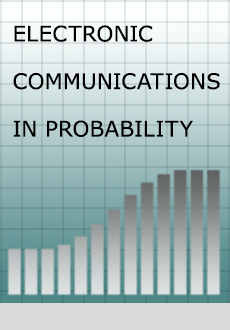Abstract
Given an infinite connected graph, a way to randomly perturb its metric is to assign random i.i.d. lengths to the edges. An open question attributed to Furstenberg ([14]) is whether there exists a bi-infinite geodesic in first passage percolation on the euclidean lattice of dimension at least 2. Although the answer is generally conjectured to be negative, we give a positive answer for graphs satisfying some negative curvature assumption. Assuming only strict positivity and finite expectation of the random lengths, we prove that if a graph $X$ has bounded degree and contains a Morse geodesic (e.g. is non-elementary Gromov hyperbolic), then almost surely, there exists a bi-infinite geodesic in first passage percolation on $X$.
Citation
Itai Benjamini. Romain Tessera. "First passage percolation on a hyperbolic graph admits bi-infinite geodesics." Electron. Commun. Probab. 22 1 - 8, 2017. https://doi.org/10.1214/17-ECP44
Information





